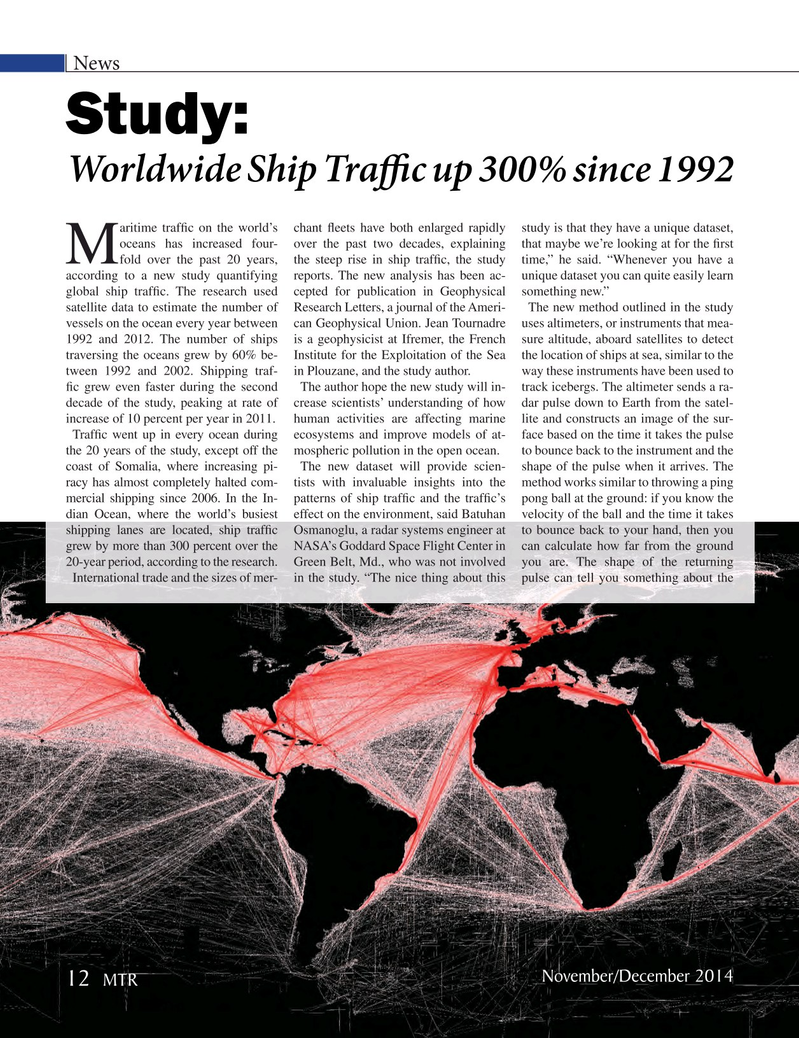
Page 12: of Marine Technology Magazine (November 2014)
Fresh Water Monitoring & Senors
Read this page in Pdf, Flash or Html5 edition of November 2014 Marine Technology Magazine
News
Study:
Worldwide Ship Traf c up 300% since 1992 aritime traf? c on the world’s chant ? eets have both enlarged rapidly study is that they have a unique dataset, oceans has increased four- over the past two decades, explaining that maybe we’re looking at for the ? rst
Mfold over the past 20 years, the steep rise in ship traf? c, the study time,” he said. “Whenever you have a according to a new study quantifying reports. The new analysis has been ac- unique dataset you can quite easily learn global ship traf? c. The research used cepted for publication in Geophysical something new.” satellite data to estimate the number of Research Letters, a journal of the Ameri- The new method outlined in the study vessels on the ocean every year between can Geophysical Union. Jean Tournadre uses altimeters, or instruments that mea- 1992 and 2012. The number of ships is a geophysicist at Ifremer, the French sure altitude, aboard satellites to detect traversing the oceans grew by 60% be- Institute for the Exploitation of the Sea the location of ships at sea, similar to the tween 1992 and 2002. Shipping traf- in Plouzane, and the study author. way these instruments have been used to ? c grew even faster during the second The author hope the new study will in- track icebergs. The altimeter sends a ra- decade of the study, peaking at rate of crease scientists’ understanding of how dar pulse down to Earth from the satel- increase of 10 percent per year in 2011. human activities are affecting marine lite and constructs an image of the sur-
Traf? c went up in every ocean during ecosystems and improve models of at- face based on the time it takes the pulse the 20 years of the study, except off the mospheric pollution in the open ocean. to bounce back to the instrument and the coast of Somalia, where increasing pi- The new dataset will provide scien- shape of the pulse when it arrives. The racy has almost completely halted com- tists with invaluable insights into the method works similar to throwing a ping mercial shipping since 2006. In the In- patterns of ship traf? c and the traf? c’s pong ball at the ground: if you know the dian Ocean, where the world’s busiest effect on the environment, said Batuhan velocity of the ball and the time it takes shipping lanes are located, ship traf? c Osmanoglu, a radar systems engineer at to bounce back to your hand, then you grew by more than 300 percent over the NASA’s Goddard Space Flight Center in can calculate how far from the ground 20-year period, according to the research. Green Belt, Md., who was not involved you are. The shape of the returning
International trade and the sizes of mer- in the study. “The nice thing about this pulse can tell you something about the
November/December 2014 12 MTR
MTR #9 (1-17).indd 12 MTR #9 (1-17).indd 12 12/9/2014 10:34:21 AM12/9/2014 10:34:21 AM

 11
11

 13
13
